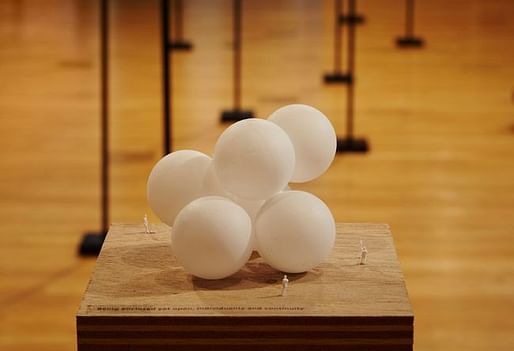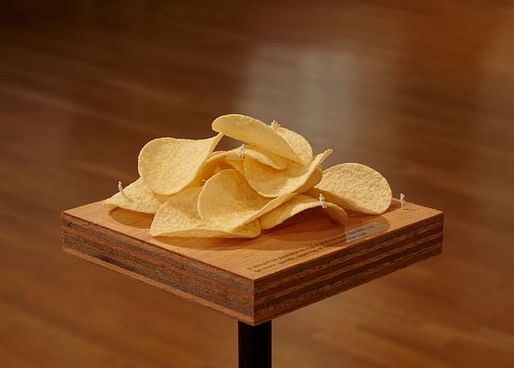

There’s a difficulty inherent to any presentation of architecture in an exhibition context: architecture (it is commonly thought) operates in the physical world, so how do you do architecture inside a gallery space? Hence, it’s pretty inevitable that a survey like the Chicago Architecture Biennial will be met with lots of questions marks and even defiant denouncements: “This is not architecture!” In general, such accusations tend to fall flat: architecture is hardly an immutable object moving through space-time.
But then again, when an exhibit is explicitly tailored to professional, academic, and lay audiences, it’s also difficult to ignore the murmurs of an exiting tourist, “I just don’t get what that has to do with architecture…” For some, the Japanese architect Sou Fujimoto’s installation Architecture is Everywhere, comprising a collection of “found architectures” – a pile of potato chips, a cardboard box, an upturned ashtray – left them scratching their heads.

There’s a whole lot to be said on this matter and, admittedly, this won’t be the place where it’s said. But – to be exceedingly reductive – one could look at the installations in the Chicago Architecture Biennial as adhering to two basic methodologies: the performative and the representational. The performative would include works like Bryony Robert’s intervention in Federal Plaza with the South Side Drill Team or, as I contended earlier this week, Tomas Saraceno’s spiders (although the latter already really blurs the distinction) – projects that attempt to do architecture. The representative, then, would describe the vast majority of the installations: displaying models, posters and photographs of actual, built projects. These are projects that seem to say, “This here is not architecture, but that there is – and this text explains what it means.”
Architects are so familiar with the representational mode from their time doing crits that they can forget that this is just one of many rhetorical strategies possible for formulating and expressing an architectural idea or way of thinking. In part, this is because architectural thinking maintains a hierarchical binary that privileges the built over the unbuilt, even if ideas are the very substance that propels the discipline in new directions. Speculative projects tend to be better received if they’re tethered to the ground: remaining in the realm of the possible or build-able.
But I’ve found that often the best projects are the ones that invent new ways to speak architecture. In this Biennial, my favorite installations tended to be the ones that trouble outmoded distinctions: between representation and performance, building and speculation, architectural thinking and architectural action. One of the most successful of these was Fujimoto’s bricolage catalogue of object.

On the one hand, the installation serves as an exquisite representation of Fujimoto’s thinking, formulated in the catalogue as “architecture is first found and then made.” But while representational of a way of thinking, the models are not 1:1 depictions of actual buildings. Rather, they’re a type of performative theory, creating a model of architectural action – that is to say, interacting with the physical morphology – that is iterable and conceptually rigorous.
Go outside and see that crumpled piece of paper not just as a possible model for an architectural object, but as an architectural object itself (yes, that’s a Simpson reference). Make an actual center for ants!
For some, Fujimoto’s installation is plain and simple “not architecture" – although, ironically enough, it's deeply embedded in historical and theoretic contexts (perhaps too much so). First of all, there are many, many architects who have pointed to objects that are ostensibly extraneous to architecture as their inspiration (Gehry’s fish, Gaudi’s forest, Eisenman’s Derrida, etc).

But what’s interesting here is the presentation. In calling his objects “found architecture,” Fujimoto seems to be saying: this stack of potato chips is itself an architecture. This is a Duchampian move, but 100 years late. That it still feels very important and relevant for architecture is either a signal of the discipline’s belatedness or Fujimoto’s salience.
In any case, you can choose to reject Fujimoto’s formulation, or allow yourself a bit of wonder, a bit of fun, as you watch your idea of architecture begin to swell, opening up to more and more possibilities.
Why argue about what is and isn't architecture when you can rejoice that it's everywhere?
3 Comments
It's so uncool to display, like, architecture
Seriously, I think Fundamentals more smartly explored the forces behind our current post-architecture. This just seems blissfully happy with the condition.
Here's potato chips! Here's some spider webs! Enjoy everybody! I feel sorry for Rahm after he had to explain this to someone...
It's somewhat hilarious how you're not commenting on Fujimoto's clear satire. That is, the potato chips are obviously Gehry's Bilbao, the staples Safdie's Habitat, etc.
Then again, it also sounds like, pace Wolfe's "The Painted Word," if it's not in the catalogue you don't see it, so...
Block this user
Are you sure you want to block this user and hide all related comments throughout the site?
Archinect
This is your first comment on Archinect. Your comment will be visible once approved.